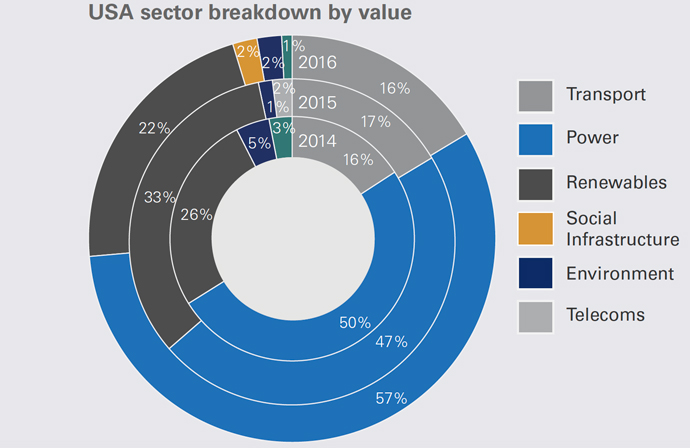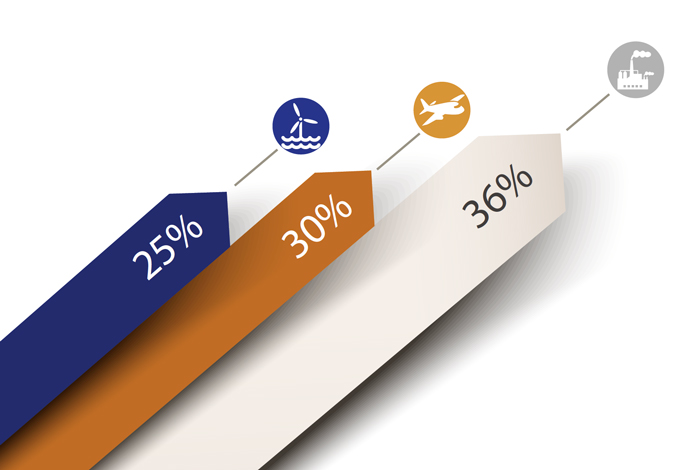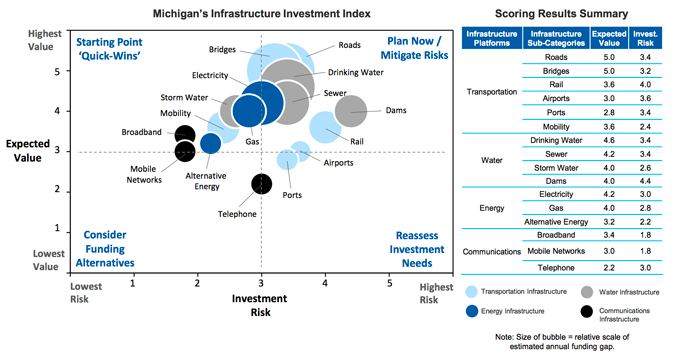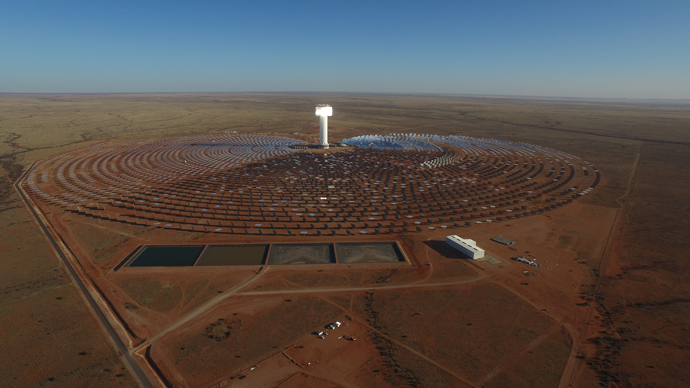InfraAmericas, part of MergerMarket’s InframationGroup operation, this week released its 2016 year in review of the US public-private partnership (P3) market. At Site Selection’s request, the research organization sent further recent reports for context. While most infrastructure financings and deals have to do with transportation projects, there’s ample evidence of the growing profile of P3 when it comes to energy projects too.
According to the US review, the United States continues to have the world’s largest project finance market, accounting for 236 deals, narrowly beating the UK’s 231 return for 2016. “At a deal value level the US accounted for US$79.42 billion, almost double that of the second biggest country, Australia,” said the report. “The US market has increased in size every year since 2006, when just 19 deals were recorded.”

The most active sectors by value in 2016 were power (US$45.27 billion), renewables (US$79.71 billion) and transportation (US$12.99 billion). By deal count the most active sectors were renewables (138), power (68) and transport (20). That renewables sector included 65 solar power deals in 2016 valued at US$8.18 billion. The power sector included 10 hydropower deals valued at US$1.77 billion.
Globally, a total of 1,439 deals closed in 2016 with a value of US$395.25 billion, vs. 1,289 deals valued at US$388.2 billion in 2015. While airport sales in London and in New York (LaGuardia) were highlights, the list of major deals also included the fall sale via long-term lease of the New South Wales electricity distribution grid to a private consortium for the equivalent of US$12 billion.
One State’s Challenges, One Organization’s Solutions
The most recent, and oft-quoted, infrastructure report card from the American Society of Civil Engineers gives the US a D+ for its energy infrastructure. Business Leaders for Michigan (a state that earns a comparatively superior grade of C-) published a study on the same day the Mergermarket numbers were released that delivers some ideas for how to fund and execute the infrastructure projects that need to happen now.
The study, conducted with assistance from Deloitte, looked at 15 US locations and 15 locations abroad, with the authors interviewing 30 industry experts and identifying 19 leading practices. Its findings support the findings of the Governor’s 21st Century Infrastructure Commission. Again, energy, while not a headlining infrastructure play, was part of the study’s scope.
 Power and renewables represent two of the three fastest growing sectors globally for PPP deals. Graph courtesy of InfraMation Group
Power and renewables represent two of the three fastest growing sectors globally for PPP deals. Graph courtesy of InfraMation GroupAmong the major energy infrastructure projects pursued in the state over the past five years are the $2-billion Ann Arbor Solar Farm completed in 2015 and the $200-million project to replace and renovate portions of Detroit’s energy infrastructure. Among those coming in the next five years is the $144-million, 114-MW New Holland natural-gas-fired power plant.
The BLM study notes that most of the state’s energy infrastructure is managed by private utilities, led by DTE and Consumers Energy. Then it names the challenges and opportunities ahead:
Challenges
- There is an increasing disruption to power supply in recent years from weather, so system resilience and building in redundancy are critical.
- There are many providers across the state.
- It is difficult for Michigan to lean on other states for power, as geography is a limitation.
- Michigan has many high-risk cast iron lines, with a 30-year cycle before all is replaced.
- A number of power generation units are closing due to new environmental standards.
Opportunities
- It is vital to repair and replace energy assets due to the direct connection between electricity and water as well as communications.
- There is an opportunity to fund natural gas pipelines at the same time with water, sewer pipelines, roads and communications assets.
- Modern technological updates in energy, e.g. smart meters to analyze outages.
- Onshore wind and solar are becoming more economical and cost effective.

Only a few of the identified best practices identified have case studies in the energy sector. Among them is South Africa, where through regulatory reform (allowing more private ownership of assets) a host of solar power generation capacity has sprung up. Through the South African Renewable Energy Independent Power Producers (IPP) Regulatory Reform, a total of 4,322 MW has been procured in less than four years to reduce reliance on fossil fuels and stimulate the renewable energy industry.
A total of $14 billion has been committed to renewable energy projects in South Africa over the past four years, including $3.5 billion from foreign investment and $4.6 billion in wind power. One project in particular, Abengoa’s KaXu Solar One thermal solar power plant in the Northern Cape region, “is expected to result in approximately $891 million direct and indirect investment inflows & generate $516M in taxes over the next 20 years to South Africa.” The 100-MW project in the town of Pofadder employed 1,000 people at peak construction, and employs 80 full-time workers now. Abengoa also is constructing the $880-million Xina One solar thermal project in South Africa, as well as the 50-MW Khi Solar One project, all under the nation’s IPP program.
“IPPs stimulate the local renewable energy industry, including developers, contractors and manufacturers,” says the BLM study, noting they also alleviate the administrative burden on the public sector, but remain transparent for stakeholders and investors. In its analysis, the study notes pluses and minuses of the approach. IPP partnerships are funded by large registration fees from bidders and the development fee paid by select bidders. They can involve a “long incubation time to produce research studies to create industry benchmarks for demand and pricing” and grid connection delays can cause unexpected monitoring delays.
“Creating a brand new industry of renewable energy IPPs is risky as there is no previous standard for market demand,” says the study. However, “it has been suggested that renewable energy IPPs are more cost-effective than traditional methods and may reach almost wholesale pricing in the near future. Michigan may consider introducing a new renewable energy IPP to meet statewide energy demand with modern technology … Implementing a renewable energy IPP may allow Michigan to become a leader in this industry.”
The risks may be outweighed by the need: The state’s infrastructure funding gap is approximately $4 billion a year.
“Michigan would benefit from coordinating the wide range of infrastructure improvements needed in a thoughtful, efficient manner,” BLM President & CEO Doug Rothwell said. “Michigan has largely been struggling to fund ‘fair to good’ levels of infrastructure when we should be striving to fund ‘better or best’ levels. Our plan identifies promising best practices that can be brought to scale. While infrastructure needs are a growing challenge across the U.S., there are key strategies — coordinating councils, asset management tools, and new funding mechanisms — that Michigan can use to make our infrastructure one of the nation’s finest.”
Among BLM’s policy principles behind its recommendations:
- Solutions should be prioritized based on economic, health and safety risks, with transportation and water systems given highest priority.
- Public-private partnerships and alternative financing methods should be fully utilized.
- Revenue should come from the users of the infrastructure — “which means all of us.” General purpose taxes (e.g., sales and income taxes) that fund the balance of state government should not be utilized.
- A renewable bond program and/or regional assessment could be used to fund one-time or recurring needs that cannot be reasonably addressed through user-based funding. However, the revenue source should not adversely impact other critical priorities that help create jobs, such as job training, higher education and economic development.
- A statewide nonpartisan, multi-infrastructure council composed of professional subject-matter experts should be established to recommend strategic prioritization of investments, maximize capture of federal dollars, facilitate public-private partnerships, oversee a coordinated asset management system and possibly coordinate projects of state significance.
“Simply put, we must become far more strategic about our infrastructure investments,” Rothwell said. “For too long, we’ve been putting out fires. We need to lay out a comprehensive plan for fixing, maintaining and expanding our infrastructure so it supports our needs now and in the future.”

